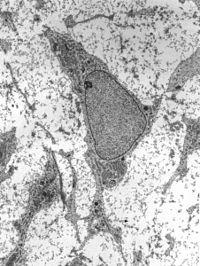
Photo from wikipedia
Simple Summary Cryopreservation and in vitro culture of germ cells are key techniques for the genetic resource preservation of the declining population of American shad. Two types of cryopreserved samples,… Click to show full abstract
Simple Summary Cryopreservation and in vitro culture of germ cells are key techniques for the genetic resource preservation of the declining population of American shad. Two types of cryopreserved samples, namely testis pieces and testicular cells of American shad, were comparatively analyzed for cell viability. The results showed that the cell viability of the cryopreserved testis pieces was much higher than that of the cryopreserved testicular cells. The viability of the cells from the cryopreserved testis pieces ranged from 65.2 ± 2.2 (%) to 93.8 ± 0.6 (%), whereas the viability of the dissociated cells after cryopreservation was 38.5 ± 0.8 (%) to 87.1 ± 2.6 (%). Moreover, the testicular cells isolated from the post-thaw testicular tissue could be cultured and propagated in vitro. Our findings would benefit further investigations on genetic resource preservation and other manipulations of germ cells in a commercially and ecologically important fish species. Abstract Germ cells, as opposed to somatic cells, can transmit heredity information between generations. Cryopreservation and in vitro culture of germ cells are key techniques for genetic resource preservation and cellular engineering breeding. In this study, two types of cryopreserved samples, namely testis pieces and testicular cells of American shad, were comparatively analyzed for cell viability. The results showed that the cell viability of the cryopreserved testis pieces was much higher than that of the cryopreserved testicular cells. The viability of cells from the cryopreserved testis pieces ranged from 65.2 ± 2.2 (%) to 93.8 ± 0.6 (%), whereas the viability of the dissociated cells after cryopreservation was 38.5 ± 0.8 (%) to 87.1 ± 2.6 (%). Intriguingly, the testicular cells from the post-thaw testicular tissue could be cultured in vitro. Likewise, most of the cultured cells exhibited germ cell properties and highly expressed Vasa and PCNA protein. This study is the first attempt to effectively preserve and culture the male germ cells through freezing tissues in the American shad. The findings of this study would benefit further investigations on genetic resource preservation and other manipulations of germ cells in a commercially and ecologically important fish species.
Journal Title: Biology
Year Published: 2022
Link to full text (if available)
Share on Social Media: Sign Up to like & get
recommendations!